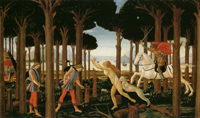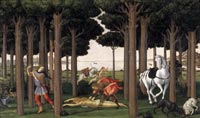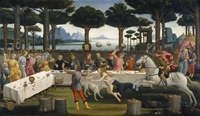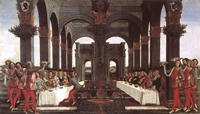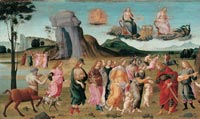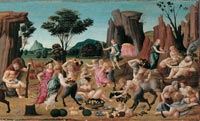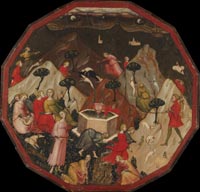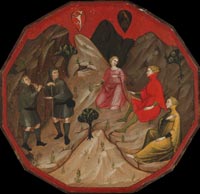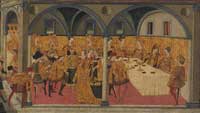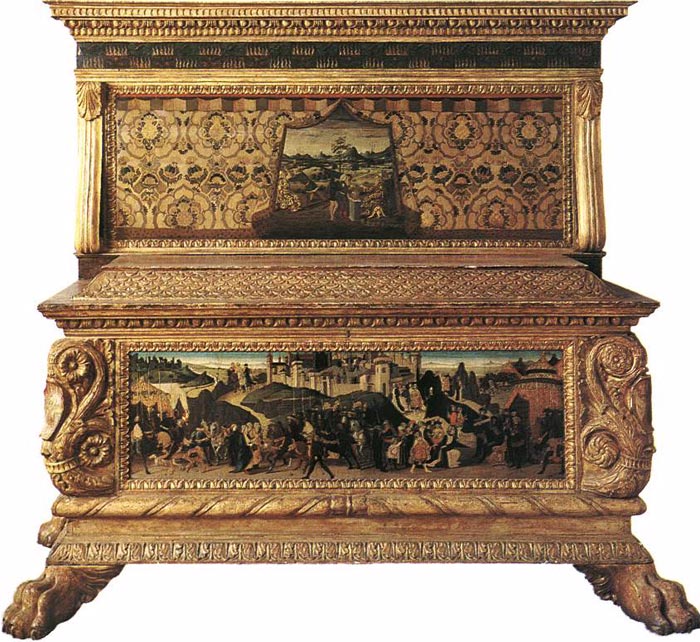 |
| Jacopo del Sellaio (1441-1493), the Nerli Cassone, also known as the Morelli Chest |
'Even the most excellent painters exercised themselves in such labors, without being ashamed, as many would be today, to paint and gild such chests.' (Giorgio Vasari, 1550, recalling cassoni painting of the previous century) |
Italian Renaissance Cassoni paintings |
| Cassoni, or marriage chests, were practical objects used to store household goods, such as clothing, linens, and valuables. But they were also luxury goods in their own right - they celebrated weddings through gold surfaces and colorful paintings made by specialized workshops. Cassoni were meant to be informative as well as delightful. The paintings often featured moral tales of ancient history or allegories derived from Italian poets such as Petrarch. The instructive function of cassoni subjects was complemented by triumphal themes that invoked honor. Cassoni revealed the ingenuity of the artists, as well as the status and ideals of their patrons. Over centuries of use, marriage chests became worn and damaged. The paintings on the fronts were often removed and sold to art collectors. |
Painted cassone made for the wedding of Lorenzo di Morelli to Donna Vaggia di Nerli and known as Morelli-Nerli Cassone depicting Camillus chases the Gauls from Rome (front panel), the side panels Justice and Fortitude, and the spaliera Horatius Cocles with the Morelli arms (left corner) and Nerli arms (right corner). Art in Tuscany | Courtauld Gallery Vodcast: Morelli Cassone, 1472 |
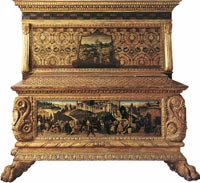 Biagio d'Antonio, Jacopo del Sellaio, and Zanobi di Domenico, chest and spalliera with the arms of Lorenzo Morelli and Vaggia Nerli, known as the Nerli Cassone |
|
 |
||
| Wedding Chest showing the Coat of Arms of the Strozzi Family. Anonymous Florentine craftsman, last quarter of the fifteenth century. Wood covered with vellum painted in tempera, gilded leather, 45 x 160 x 47 cm. Grassina (Florence), Carlotta Bruschi Collection. Collezione Carlotta Bruschi, Grassina © Fotografía: Giusti Paolo e Claudio | ||
|
||
Cassone, with scenes from Boccaccio’s Decamerone |
||
 |
||
Workshop of Giovanni Toscani, Cassone, with scenes from Boccaccio’s Decameron (the tale of Ginevra, Bernabò and Ambrogiuolo (part I), c. 1420-25, wood, gesso, tempera and gilding, 82.5 x 195.5 x 68.6 cm (overall), Edinburgh, National Galleries of Scotland |
||
Giovanni Toscani matriculated in the Florentine Compagnia di S Luca in 1424, but it seems that already in 1420 he was inscribed on the rolls of the company (Orlandi). In 1423 and 1424 he received payments for decorating the Ardinghelli Chapel in Santa Tr?nita, Florence (Milanesi). In the catasto (land registry declaration) of 1427, Toscani described himself as a cassone painter ('cofanaio').Also on display are panels painted by Giovanni Toscani (act. 1423, d. 1430). One of his works depicts a story from Boccaccio's Decameron in three scenes. Bernabo, a wealthy merchant from Genoa, makes a bet with a young man, Ambrogiuolo. Bernabo is so convinced of his wife's virtue that he believes Ambrogiuolo will not succeed in seducing her. Ambrogiuolo is smuggled into Ginevra's bedroom. After discovering a mole under Ginevra's breast, he convinces Bernabo of his success. The young man was punished by being stung to death by bees! Pesellino, whose original name was Francesco Di Stefano, also called Giuichi, was known for his cassone paintings. Pesellino in particular was known for favoring old legends and tales in his designs. Examples of Pesellino's cassoni can be seen in the Gardner Museum, Boston MA, the National Gallery of Art, Washington DC, the New York Metropolitan Museum of Art, and the Museum of Art in Toledo Ohio. |
||
|
||
 |
||
Francesco Pesellino (Italian, Florence, 1422–1457), The Triumphs of Love, Chastity, and Death, about 1450, tempera and gold on wood, 45.4 x 157.4 cm, Isabella Stewart Gardner Museum, Boston |
||
 |
||
Francesco Pesellino (Italian, Florence, 1422–1457), The Triumphs of Fame, Time, and Eternity, ca. 1450, Isabella Stewart Gardner Museum, Boston |
||
'In characteristic fashion, Bernard Berenson paid court to his patron, complimented her discernment, and spurred her acquisitiveness and rivalry with other collectors. Gardner was indeed lucky to get the two Pesellino panels since in the latter half of the nineteenth century, dealers and collectors had raised the demand for Renaissance painted wedding furniture. The cassone panels feature five parade floats, forming a grand procession that culminates in a celestial vision of God at the end of time. The imagery derives from Petrarch’s fourteenth-century allegorical poem, The Triumphs of Love, Chastity, Death, Fame, Time, and Eternity. In his letters to Gardner, Berenson singled out the final tableau for praise, but he referred to it as the triumph of Religion rather than Eternity; presumably this substitution of titles was calculated to appeal to Gardner’s deepening piety. Religious sentiment mingled with courtly love proved irresistible, so it’s no wonder that Berenson also deliberately tailored his description of the first panel to include the triumph of “Chivalry” rather than Petrarch’s more conventional Fame. With such coded language, Isabella Stewart Gardner and Bernard Berenson shaped history through imagination and fantasy; they engaged with the Renaissance past through scholarship, research, and travel, but they also enjoyed the role-playing of a good costume drama!'
[3] |
||
 |
||
DOMENICO DI MICHELINO, The Triumph of Fame, the Triumph of Time and the Triumph of Eternity, tempera on panel, gold ground, 42 x 177 cm, private collection |
||
| During the early fifteenth century, Europe continued to evolve out of a series of medieval feudal states ruled by wealthy landowners into concentrated town centers or cities functioning as powerful economic nuclei. As these cities took on greater political and financial authority, the middle classes, made up of artisans, bankers, and merchants, played more substantial roles in commerce with their greater wealth and independence. Along with this prosperity, particularly marked in Italy, an increased number of palaces and villas were constructed, subsequently creating a greater demand for extravagant furniture and domestic art, both for established aristocratic patrons and the newly wealthy. (...) The manufacture of secular art objects, usually for the purpose of commemoration, personalized these lavish Italian Renaissance interiors. Because childbirth and marriage were richly celebrated, a number of objects were made in honor of these rituals. The wooden birth tray, or desco da parto, played a utilitarian as well as celebratory role in commemorating a child's birth. It was covered with a special cloth to function as a service tray for the mother during confinement and later displayed on the wall as a memento of the special occasion. A desco da parto was usually painted with mythological, classical, or literary themes, as well as scenes of domesticity. The reverse often displayed a family crest. In some cases, a birth tray was purchased already painted, but custom-decorated with heraldry that personalized what might otherwise be a line item from a shop. The Metropolitan's Triumph of Fame by Lo Scheggia, Masaccio's younger brother, is the finest and most extravagant surviving example of a birth tray. It is noteworthy for its condition, beauty, and association with the great Florentine Medici family. This tray was specially commissioned by Piero de' Medici and Lucrezia Tornabuoni to commemorate the birth of their first-born son Lorenzo. | ||
Cassoni are possibly the best-known classification of furniture whose distribution is limited to a particular region. They demonstrate many of the trends that shaped the evolution of furniture. Cassoni mix the contemporary style of the day with more traditional features of the past. They also frequently utilize paintings and sculptures of premier artisans. 6 Also according to Britannica, the 15 th century was when the importance of marital alliances between the wealthy in Florence reached its zenith, and it was during this time that the cassone were decorated by some of the greatest artists of the period. Artists who contributed to the decoration of cassone include Sandro Botticelli, Paolo Uccello, and Donatello. |
||
 |
||
Sandro Botticelli, Mars and Venus, tempera on panel, c. 1483, National Gallery, London, United Kingdom |
||
| Above we have and example of a cassone front by Sandro Botticelli, on display at the National Gallery, in London, England. Only the front panel of this piece survives.
Botticelli was only one of the great artists to contribute to cassone decoration whose works were later despoiled to provide wall hangings.
|
||
Sandro Botticelli | Storia di Virginia Romana |
||
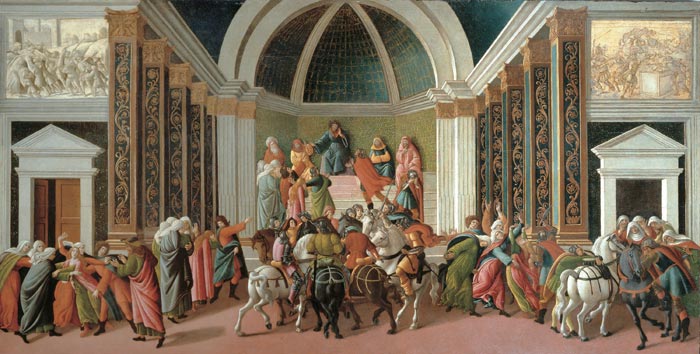 |
||
Sandro Botticelli, Storia di Virginia Romana, Bergamo, Accademia Carrara |
||
| In the 1480s Botticelli gained commissions from the families in high society. Increasingly they chose classical themes for the luxurious decoration of their town houses, but they also included some from contemporary literature. In order to be able to carry out his multiple commissions, Botticelli had to work together with other painters as well as members of his own workshop. In 1483 he creates a painting in the most exquisite colors and details, a scene of horror and drama. At a banquet nestled among pine trees, a beautiful nude girl rushes through, screaming and sobbing as she’s attacked by mastiffs and chased by an angry man on horseback. The crowd starts up in terror. The intensity of the scene contrasts with the placidity of the sea in the distance. The four panels conveying the Story of Nastagio degl Onesti, the eighth novel of the fifth day of Boccaccio's Decameron, were produced with the aid of Bartolomeo di Giovanni. The Story of Nastagio degl Onesti is the story of Nastagio, a young man from Ravenna who was rejected by the daughter of Paolo Traversari and abandoned the city to settle on its outskirts. Nastagio degli Onesti, whose beloved initially refused to marry him, finally weds her after all. First of all, however, he must remind her of the eternal agony in hell of another merciless woman, one who had also refused marriage, her rejected lover had to pursue her until he had caught up with her, killed her, torn out her heart and intestines and fed them to his dogs. |
||
Sandro Botticelli and Bartolomeo di Giovanni, The Story of Nastagio degl Onesti |
||
 |
||
Sandro Botticelli and Bartolomeo di Giovanni, La historia de Nastagio degli Onesti (third episode, detail), 1483, Madrid, Museo Nacional del Prado |
||
Although much of the art of Renaissance Italy revolved around Christian and classical themes, at times artists also painted scenes from contemporary literature for their wealthy patrons. Such is the case with Botticelli’s Story of Nastagio degli Onesti. The painting depicts in tempera a scene from a contemporary novella called The Decameron, an allegorical work of storytelling written by Italian author Giovanni Boccaccio. The Decameron consists of 100 tales of love, tragedy, wit, and practical jokes. The stories are framed by a narrative about seven women and three men who flee the woes of the Black Death in Florence to a villa in the countryside. They tell stories to pass the time and enjoy one another’s company. The Decameron is important for its documentation of life in the 14th century. Most likely the panels were destined to be installed on the walls of newlyweds in a family palace. Typically sons continued to live in their father’s house after marriage; their rooms would undergo new decoration which would include painted wall panels. These would be the only luxury in rooms which were, in contrast, simply furnished. Art in Tuscany | Sandro Botticelli and Bartolomeo di Giovanni, The Story of Nastagio degl Onesti |
||
Bartolomeo di Giovanni, The wedding of Thetis and Peleus |
||
 |
||
Bartolomeo di Giovanni, The wedding of Thetis and Peleus, detail. Panel of a cassone (wedding chest), Louvre, Paris |
||
Bartolomeo di Giovanni, also known as Alunno di Domenico, was an early renaissance Italian painter of the Florentine School who was active from about 1480 until his death in 1501. He studied with and assisted Domenico Ghirlandaio, painting the predella of Ghirlandaio's Adoration of the Magi in the Ospedale degli Innocenti (Foundling Hospital) in Florence, in 1488. Bartolomeo di Giovanni also worked under the guidance of Sandro Botticelli. |
||
| Alessando di Mariano Filipepi detto Botticelli, Filippino Lippi La regina Vasti lascia il palazzo reale Firenze, Museo Horne |
||
|
||
Jacopo del Sellaio (1441-1493) | Story of Cupid and Psyche |
||
 |
||
Jacopo del Sellaio (1441-1493), Story of Cupid and Psyche, The Fitzwilliam Museum, Cambrdge University |
||
Another reference in favor of the compound reading of Botticelli's masterpieces is perhaps found also in the painting of his friend Jacopo del Sellaio (1441-1493). The two paintings (Fitzwilliam Museum) from a wooden marriage chest painted by Jacopo del Sellaio [4] are describing the myth of Cupid and Venus, and serve as an interesting reference to Botticelli's collage. Vasari describes both Sellaio and Botticelli as fellow pupils in the workshop of Fra Filippo Lippi, which makes a comparison particularly interesting. If we are to believe in the established dating of the artworks, then Sellaio executed the paintings some decade before Botticelli, even though he is usually considered as heavily influenced by Botticelli's work. Jacopo del Sellaio painted at least fifteen(4) distinct episodes of the myth on two panels at the different sides of a marriage chest. The difference between the compositions of two painters is obvious: Sellaio is primarily describing the story as told by the classics whereas Botticelli is more mystical, more valuable are the subtle levels of an intuitive apprehension of the story than an appropriate description of narration. However, more interesting is a purely formal comparison, which enhances some previously drawn conclusions about the nature of Botticelli's inspiration considering the compound image of the Birth of Venus and La Primavera. |
||
Master of 1416 | Ameto's Discovery of the Nymphs |
||
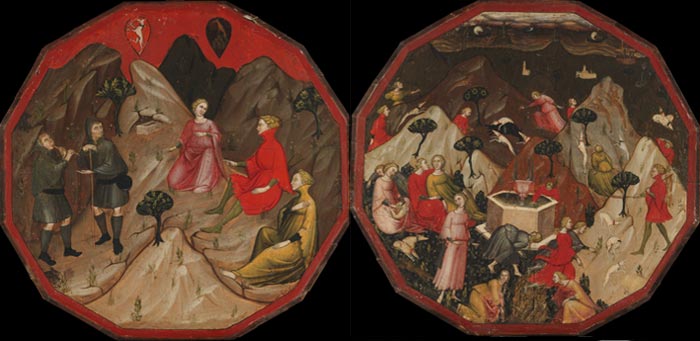 |
||
Master of 1416 (Italian, Florentine, early 15th century), twelve-sided childbirth tray (desco da parto) with scenes from Boccaccio's Commedia delle ninfe fiorentine: Ameto's Discovery of the Nymphs and Contest between the Shepherds Alcesto and Acaten, ca. 1410, The Metropolitan Museum, New York |
||
| The Master of 1416 is the name given to the painter of an altarpiece of the Madonna and Child Enthroned with Saints, dated 1416, in the Galleria dell'Accademia, Florence. The panels are the recto and verso of a marriage salver. They show episodes from the Commedia delle ninfe fiorentine, an amatory allegory written about 1342 by Giovanni Boccaccio. On the left panel Ameto and two nymphs judge a musical competition between the shepherds Alcesto and Acaten. The arms at the left correspond with those of the Fortuna family of Florence, except for the sword. The arms on the right may belong to the Di Lupo Parra family of Pisa. The right panel, the obverse, or front, of a marriage salver, illustrates an episode in which the hunter Ameto, dressed in red, peers over a hill and then approaches some nymphs in a thicket, attracted by the singing of Lia. In the background Ameto and the nymphs hunt. The nymphs instruct Ameto in the meaning of love in a later episode of the story. The narratives of Ameto and the nymphs continues on a panel that was in all likelihood originally the verso of the birth tray above, but the two are now separated. Ameto, in the same high-collared red tunic, and two nymphs listen to a musical competition between the shepherds Alcesto, who represents leisure, and Acaten, who represents industry. The incident was a critical prelude to Ameto's embrace of the virtuous life. One of the coats of arms has been identified as that of the Di Lupo Parra family of Pisa. The salver dates about 1410.[2] This birth tray is apparently the only extant illustration to Giovanni Boccaccio's Comedia delle Ninfe Fiorentine, an amatory allegory written about 1342 that recounts how the hunter Ameto is educated in love by nymphs. The obverse shows Ameto's discovery of the nymphs: "Some, displaying their white feet in the shallow ripples [of the little stream], were slowly wading through them this way and that; others, who had laid down their sylvan bows and arrows, held their hot faces suspended above the stream, and having tucked up their sleeves were renewing their beauty with their fair hands and cool waters; and some, having loosened their clothing to let in the breezes, were sitting attentive to what one of them, more joyous than the others, sat singing. " In the background Ameto and the nymphs hunt together On the reverse (below) Ameto and two nymphs judge a musical competition between the shepherds Alcesto and Acaten, one of whom praises a life of leisure and the other a life of industry. In Boccaccio 's story this is the prelude to Ameto's final transformation from a rustic into a rational man and his realization that the nymphs are, in fact, the virtues. The right-hand coat of arms is that of the Di Lupo Parra family of Pisa, the other is unidentified. The birth tray was painted about 1410 by an associate of Lorenzo di Niccolb, who is known as the Master of 1416. |
||
|
||
Benvenuto di Giovanni, The Triumph of David |
||
 |
||
Benvenuto di Giovanni, The Triumph of David, (ca. 1459-60 ), Siena, Pinacoteca Nazionale |
||
The panel, from the vestry of the church of San Francesco in Siena, was originally the front part of a nuptial chest executed for the wedding of two members of the Buonsignori and Piccolomini families as shown by the two coats of arms. It represents a nuptial theme: David, after having killed Goliath, getting on a triumphal chariot in Jerusalem to marry the daughter of the king, Michal. |
||
| Francesco Pesellino (1422–1457), Triumphs of Love, Chastity, and Death, c. 1450, Isabella Stewart Gardner Museum, Boston. Francis Petrarch’s poem cycle The Triumphs, c. 1370, provides the subject matter for this chest. | ||
| Pesellino shop, Liberal Arts, Birmingham Museum of Art, Birmingham, Alabama. The seven liberal arts—arithmetic, geometry, music, astronomy, logic, rhetoric, and grammar—made up the Trivium and the Quadrivium of the premodern curriculum. |
||
| Pesellino shop, Seven Virtues, Birmingham Museum of Art, Birmingham, Alabama. In the depiction of the seven virtues—Prudence, Justice, Faith, Charity, Hope, Fortitude, and Temperance | ||
| Biagio d'Antonio (1446–1516) and shop, Camillus Brings Statue of Juno to Rome, c. 1470, Samuel H. Kress Collection, National Gallery of Art, Washington, D.C. | ||
| Giovanni di Ser Giovanni, Lo Scheggia (1406–1486), Frederick III and Leonora of Portugal in Rome, 1452, Worcester Art Museum, Worcester, Massachusetts. |
||
Biagio d'Antonio, Scenes from the Story of the Argonauts |
||
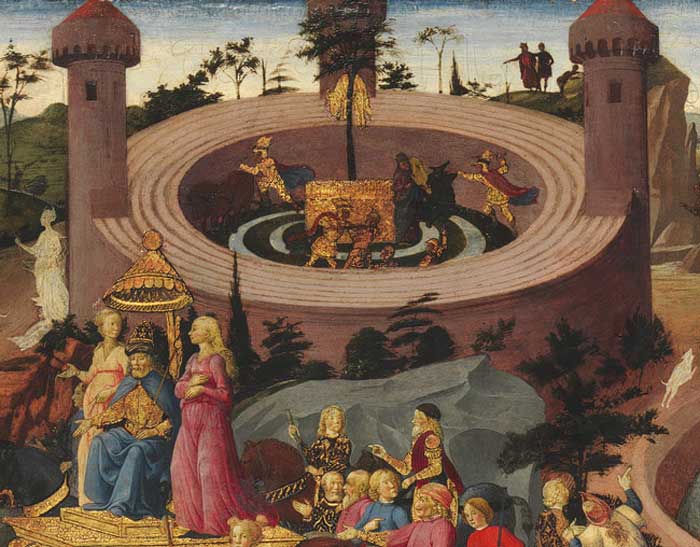 |
||
These two panels with lively depictions of scenes from the stories of Jason and the Argonauts were designed either as the fronts of cassoni or as spalliere, hung at above shoulder height. As with other complex narrative constructions of the period, such as some of Ghiberti's compositions for the bronze doors of the Baptistery of Florence, the stories proceed across the picture plane and in depth, and the illusionistic manipulation of space through perspective is central to their effect. |
||
| Along with another panel (J. Paul Getty Museum, Los Angeles), this spalliera was probably once installed in the wainscoting of a bedroom. As the inscriptions clearly identify, it tells the story of Joseph—gvseppo—in Egypt. Beginning with his arrival there, in the background at the left, it includes scenes of his flight from the unwanted advances of Potipher's wife; his imprisonment and the interpretation of Pharaoh's dreams; and finally his reconciliation with his brothers. It may be that the virtues Joseph demonstrated—chastity, constancy, and clemency—were considered of particular value to a young bride and groom. |
The Story of Joseph, after 1482 Biagio d'Antonio (Italian, Florentine, active 1472–1516) Tempera on panel |
|
Marco del Buono Giamberti and Apollonio di Giovanni di Tomaso, The Story of Esther |
||
 |
||
Marco del Buono Giamberti and Apollonio di Giovanni di Tomaso, The Story of Esther (detail), 1460–70, The Metropolitan Museum of Art, New York |
||
This panel depicts an episode from the biblical story of Queen Esther and King Ahasuerus (Esther 2:17–19); it once adorned the front of a cassone, or wedding chest. Esther, a Jewess, competes with other virgins of the kingdom of Shushan to marry the king. He chooses her, and we see the wedding feast unfolding over time across the panel. The artist portrays the event in a Florentine Renaissance setting: a palace like that belonging to the Medici rises behind the procession; a church resembling the Duomo is at center; and the banquet and marriage take place in an outdoor loggia. The story of Esther was dramatized in mystery plays of the late Middle Ages, and the representation of the narrative here may reflect those popular plays.["Marco del Buono Giamberti and Apollonio di Giovanni di Tomaso: The Story of Esther (18.117.2)". In Heilbrunn Timeline of Art History. New York: The Metropolitan Museum of Art, 2000–. http://www.metmuseum.org/toah/works-of-art/18.117.2 (November 2008)] |
||
|
||
Guidoccio di Giovanni Cozzarelli, The Legend of Cloelia, ca. 1480 |
||
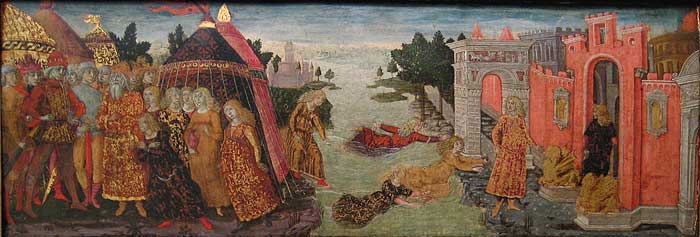 |
||
Guidoccio di Giovanni Cozzarelli, The Legend of Cloelia, ca. 1480, The Metropolitan Museum of Art, New York |
||
| Plutarch (Life of Publicola, XIX) describes how in a peace treaty the Romans offered Lars Porsena ten young noblemen and ten maidens as hostages. While the maidens were bathing in the Tiber, Cloelia got them to escape. On the left the maidens are presented to Porsena. In the center they swim the Tiber and, on the right, they escape through the gates of Rome. The paneldates from about 1480. Art in Tuscany | Guidoccio di Giovanni Cozzarelli |
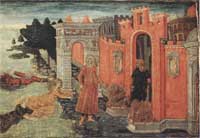 |
|
|
||
Lo Scheggia | Triumph of Fame |
||
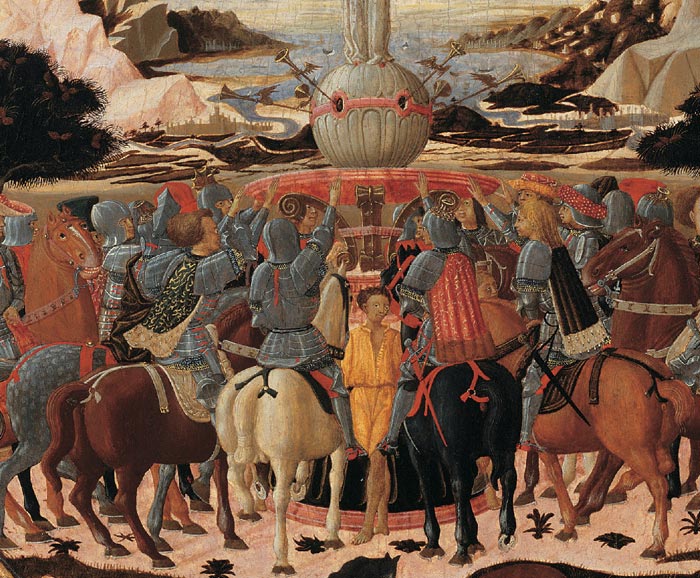 |
||
Lo Scheggia, Childbirth tray (desco da parto) with the Triumph of Fame (recto, detail), 1448–49, tempera, silver, and gold on panel, The Metropolitan Museum of Art, New York |
||
| The Metropolitan's Triumph of Fame by Lo Scheggia, Masaccio's younger brother, is the finest and most extravagant surviving example of a birth tray. It is noteworthy for its condition, beauty, and association with the great Florentine Medici family. This tray was specially commissioned by Piero de' Medici and Lucrezia Tornabuoni to commemorate the birth of their first-born son Lorenzo. It is the largest and most elaborate surviving birth tray. Twenty-eight men on horseback are shown pledging allegiance to Fame, a beautiful winged woman who holds a sword and a statuette of Cupid as she stands atop a globe on an enormous pedestal. This scene, known as the Triumph of Fame and based on Boccaccio's Amorosa Visione (1342) and Petrarch's Trionfi (1354–74), clearly shows the dynastic ambitions of Piero de' Medici, Lorenzo's father, who commissioned the work and gave it to his wife Lucrezia Tornabuoni. The tray must have had considerable commemorative value to Lorenzo, as it was hanging in his bedchamber at the time of his death. |
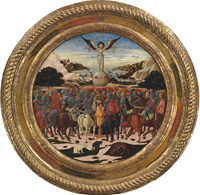 |
|
Master of Charles of Durazzo, The Conquest of Naples by Charles of Durazzo |
||
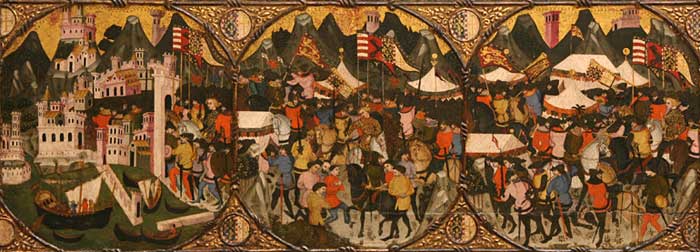 |
||
Master of Charles of Durazzo (Italian, Florentine, late 14th century), The Conquest of Naples by Charles of Durazzo |
||
| This panel represents three scenes from the conquest of Naples by Charles III of Durazzo in 1381. On the right, Charles wages war against Otto of Brunswick. Otto submits to Charles in the center, and on the left Charles enters the city of Naples as victor. | ||
Virtu' d'Amore or Nuptial Art Exhibit, at La Galleria dell'Accademia in Florence |
||||
Love and Marriage in Renaissance Florence: The Courtauld Wedding Chests, 12 February – 17 May 2009, The Courtauld Institute of Art, Somerset House, Strand, London. |
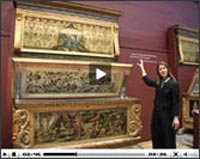 |
|||
The exhibition Love and Marriage in Renaissance Florence: The Courtauld Wedding Chests is the first in the UK to explore this important and neglected art form of Renaissance Florence. The exhibition is focused around two of The Courtauld’s great treasures: the pair of chests ordered in 1472 by the Florentine Lorenzo Morelli to celebrate his marriage with Vaggia Nerli. These are the only pair of cassoni to be still displayed with their painted backboards (spalliere).The unusual survival of both the chests and their commissioning documents enables a full examination of this remarkable commission. Selected from The Courtauld’s extensive collection, these drawings illustrate the increasing use of classical motifs in High Renaissance designs. They also testify to the increasing professionalism of design in the High Renaissance, when the artist who was commissioned to design an object was often a different person from the craftsman who executed the design. This tradition of collaborative design has particular relevance in today’s artistic climate, where the line between functional object and work of art has become ever less marked. |
||||
[1] During the 14th century there was an artistic and cultural revolution. The main thrust of this transformation, which started in the city-states of northern Italy, was a revived confidence in the power and dignity of humanity. Society began to examine contemporary artists in light of classical antiquity. It was at this time that society began to admire artists as inspired creators, and their social status was elevated by the patronage extended by popes and other influential figures in Rome. In Florence, the vision of a new art with a passion for realism began to dominate the minds of the Italian masters. The "universal" or "Renaissance" man was well read in the classical texts; he could also master the complexities of engineering, science and military works. Growing attention to anatomy and perspective allowed sculptors and architects to fashion three-dimensional forms with greater assurance than ever before. Furniture-makers were inspired to blend architectural columns, pilasters and pediments with motifs from the rich and varied classical repertoire into their lavishly decorated constructions. In the search for an alternative to the dominant Gothic esthetic, the glamour of the new Italian achievement became irresistibly appealing throughout all Europe. To the visitor from England or France, the great palaces of Florence, Venice, Genoa, Milan and Rome must have seemed unbelievably rich and luxurious. The walls of the main rooms were often frescoed by the greatest artists; ceilings were boldly carved and nearly always gilded; floors were inlaid with marble. There was an abundance of costly fabrics. Sideboards were decked with massive, intricately wrought silver ewers and basins. In the smaller rooms there might be oil paintings on the walls, exquisite little bronze statuettes on tables, and less finely worked bronze andirons in the fireplace. Cassoni – marriage chests – were the most elaborate pieces of furniture to be found in an Italian palace in the early 16th century. They were made by craftsmen who seem to have held themselves rather above the common falegnami – household carpenters and joiners responsible for the rougher objects of furniture – and belonged to a separate guild. These cassoni were made to contain a bride's trousseau and were decorated not only with the coats of arms of her family and those of her intended husband, but with relief ornament, swags of fruit, panels of wooden mosaic in patterns (intarsia) or narrative paintings taken from the Bible and classical mythology. Often they were made in pairs. The painted, carved and gilded "Conquest of Trebizond" chest at the Metropolitan Museum of Art in New York City has the grandeur of the full-fledged early Renaissance cassone. The flat, painted panel depicting Trebizond -- one of the Greek states that sprang up in 1204 after the overthrow of the Byzantine Empire by the army of the Fourth Crusade -- was decorated by Marco del Buono, who ran one of the largest of the workshops that made painted marriage chests in Florence in the mid-15th century. These gilded and carved gesso objects, the symbols of dynastic patronage and achievement, were replaced in the later 16th century by cassoni made for brides in general rather than for a specific bride. In carved and polished walnut, these cassoni were fashioned in the form of antique sarcophagi, all their surfaces patterned with acanthus foliage around reliefs of classical scenes. The Italian architect and designer Giorgio Vasari said in the 1550s that it was "the custom at that time for all citizens to have large coffers or chests of wood in their chambers, made like a sarcophagus…and nobody failed to have these chests adorned with paintings, and in addition to the stories, which were usually depicted on the front and cover of these coffers, the ends, and frequently other parts, were commonly adorned with the arms and other insignia of the respective families." The greater the family, the more ostentatious the chest or cassone. Vasari also described how the painted cassone gave way to the carved cassone: "The custom prevailed, after no long time, of forming richer decoration, by carving in natural wood, covered in gold, which did indeed produce most rich and magnificent ornaments." The flat, Gothic, painted surfaces of the 15th century were largely superseded by assertive sculptural carved ornament, which originated in antique stone ornament. The obvious classical models for carved chests were the numerous late antique funerary sarcophagi, carved with vigorous human figures, lion-paw feet, acanthus decoration, and given a bombé or kettle shape. The furniture that resulted, whatever its modern purpose, reflected the weight and solemnity of antique stone. Such architectural forms in furniture exhibit an elaborate grandiosity and controlled richness that reflect much of the antique Roman spirit. During the 19th century, collectors and connoisseurs prized Italian cassoni as tangible symbols of the Renaissance, and because of the elaborate painting and carving incorporated in the chests, many people continue to treat them as fine art objects. [WENDELL GARRETT, senior vice president of American Decorative Arts at Sotheby's]. [2] The right panel, probably the front of a birth tray, is the earliest representation of Boccaccio's novella, written about 1342. In the first scene, the hunter Ameto, behind a hill on the far right and wearing a tunic, discovers a group of nymphs hunting, bathing, and singing in a luxuriant landscape. In the second of the multiple narrative scenes, Ameto strides toward the nymphs, joining their group so that he may learn about love and virtuous living. Boccaccio's Commedia delle ninfe fiorentine suggests the close link between love and virtue in the Renaissance mind. The married couple to whom this tray belonged and whose union had, or hoped to have, offspring would have known the story and taken inspiration from it. The panel was probably painted by a master of a prolific workshop of the Florentine artist Lorenzo di Niccoló (active 1371–1420). ["Master of 1416: Childbirth tray (desco da parto) with scenes from Boccaccio's Commedia delle ninfe fiorentine: Ameto's Discovery of the Nymphs and Contest between the Shepherds Alcesto and Acaten (26.287.1,2)". In Heilbrunn Timeline of Art History. New York: The Metropolitan Museum of Art | www.metmuseum.org ] See also Deborah L. Krohn, Birth and Family in the Italian Renaissance and Andrea Bayer, Paintings of Love and Marriage in the Italian Renaissance. [3] Source: Cristelle Baskins, "'Rare and Wonderful' Marriage Pictures," in Eye of the Beholder, edited by Alan Chong et al. (Boston: ISGM and Beacon Press, 2003): 64-67. [4] Jacopo da Sellaio (1442-1493). Sometimes known as Jacopo di Arcangel, Sellaio was an eclectic Italian painter from the early Renaissance, who painted in the style of the Florentine School. He was a pupil of Fra Filippo Lippi, with his contemporary Sandro Botticelli , who became a lasting influence on him. It is noted that by 1460 he had joined the Confraternity of Saint Luke (Compagnia di S Luca) in Florence, and in 1473 he is documented to have shared a studio with Filippo di Giuliano. A number of his paintings were commissioned for decorative wedding chests, or a cassoni, such as his Story of Cupid and Psyche commissioned for a 15th Century Florentine marriage. The latter depicts the ancient marriage of the mortal princess, Psyche to the god of love, Cupid. He executed another wedding cassone, The Nerli Cassone in collaboration with Zanobi di Domenico and Biagio d'Antonio in 1472. His piece now in the Uffizi Gallery, The Banquet of Ahasuerus, was also painted, along with two other panels, including, Esther before Ahasuerus, for a cassoni. These panels depict biblical scenes from the Old Testament. His small devotional pieces were well known, several of which depicted Saint Jerome and Saint John the Baptist. He also painted religious works for the church of San Lucia dei Magnoli and the church of San Frediano, both in Florence. [5] Pope-Hennessy, John, and Keith Christiansen. "Secular Painting in 15th-Century Tuscany: Birth Trays, Cassone Panels, and Portraits." The Metropolitan Museum of Art Bulletin, v. 38, no. 1 (Summer, 1980), p. 23. | PDF |
||||
|
||||
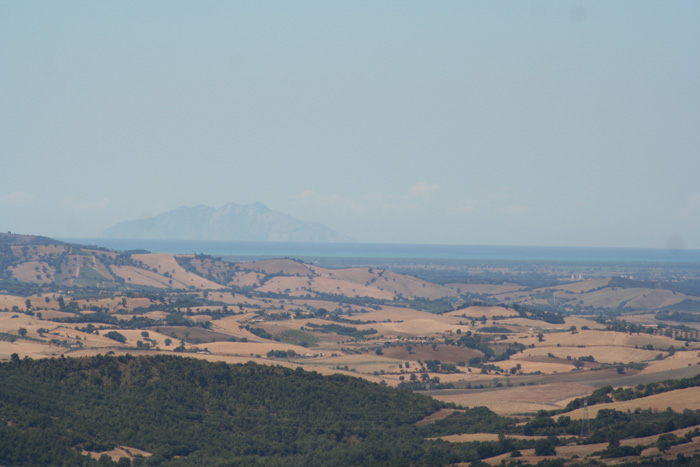 |
||||
 |
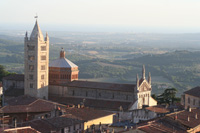 |
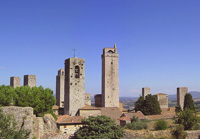 |
||
Sant'Antimo, between Santa Pia and Montalcino |
Massa Marittima | The towers of San Gimignano | ||
 |
||||
| Montecristo. Situated in panoramic position, overlooking vineyards and olive trees, Santa Pia features incredible sunsets... |
||||

